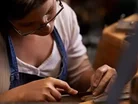Bridging the technical skills gap in manufacturing

British manufacturing is facing a major skills shortage and according to the EEF Skills Report 2016, technical ability and understanding of new software are among the top gaps in the industry. This is due to a combination of pressures; economic uncertainty that has resulted in a decrease in graduate hires, and an ageing, retiring workforce, which, when combined, mean that there are not enough workers to meet the growing demand. To secure the future of UK manufacturing therefore, it has never been more important for companies to attract young, talented, creative and original thinkers to help plug the skills gap.
Although engaging the next generation in schools and universities helps to future-proof businesses, more needs to be done to increase enthusiasm about the industry and perhaps more pertinently, to stop top talent from flocking to digital-first companies in other industries. However, this is no easy feat, especially when there is a stigma around engineering work being confined to the production line. To attract a generation that’s grown-up with digital technology at their fingertips, companies will need to meet their technological desires by adopting and showcasing new innovations, such as advanced design tools, additive manufacturing and connectivity.
Attracting new talent using technology
Littlehampton Welding, a specialist steel fabricator, is a great example of how adopting cutting edge technologies can help attract a younger workforce. The company grabbed the attention of a talented young fabricator because it was using advanced manufacturing solutions, alongside Building Information Modelling (BIM) tools that he’d never encountered before, as they are traditionally used in the construction industry.
The young recruit was able to use the BIM tools immediately when Littlehampton asked him to help out on a collaborative sculpture project at Goodwood Festival of Speed. This was a complex project with numerous process challenges – from learning how to manage the project schedule to delivering on the client conception and installation – which put his new-found skillsets to the test. In doing so, he was also able to learn more about visualising objects through 3D modelling – a key tool for advanced manufacturing.
Driving the skills shortage down
As the nature of manufacturing changes, and the industry shifts to be more high-tech and design-focused, it will require a new set of skills from the workforce. The future of making things has lessened the need for hands-on manufacturing and has instead evolved the industry to a state where machines are not only able to be programmed to ‘do’, but also to think and adapt.
For example, through generative design – the use of smart algorithms that mimic nature’s approach to design – we no longer have to tell machines what we want, instead they now understand our requirements. It's a completely new way of designing that in theory, removes the element of human error and comes up with utterly new ways of creating objects. This requires a digitally-capable workforce that can manage these machines and optimise the production line through them.
Recruiting top talent will therefore be essential. But as we’ve seen with Littlehampton, enhancing the workforce’s skillset doesn’t necessarily stop within the manufacturing sphere. Some sectors will require employees to learn about the latest advancements in construction technologies, such as BIM, as design technologies slowly blur the lines between these two industries.
Offering part-time work placements to students who are still at university is another way that traditional manufacturing companies can attract top talent with fresh ideas, who are often more willing and inquisitive to explore the impossible. While students will be getting hands-on experience, they will also be helping their employer to try, test and learn new technologies and accelerate their journey towards the future of making things.
To ensure a brighter future for British manufacturing, businesses must continue to adopt new technologies. There is no doubt that the evolution of the factory floor is going to progress even further and that companies will need to ensure they are keeping on top of the trends to stay ahead of the curve. Failure to do so will leave them at risk of not only losing out on the top talent that will underpin their competitive edge, but also, future customers and prospects as well.
By Asif Moghal, Senior Manufacturing Industry Manager, Autodesk
Follow @ManufacturingGL and @NellWalkerMG
- Make UK & Autodesk: UK Manufacturers Lagging Behind on AIAI & Automation
- CBI Industrial Trends Survey shows positive expectations for growthLean Manufacturing
- The top three trends driving the factory of the futureTechnology
- Autodesk announces comprehensive 3D manufacturing tool kitLean Manufacturing

